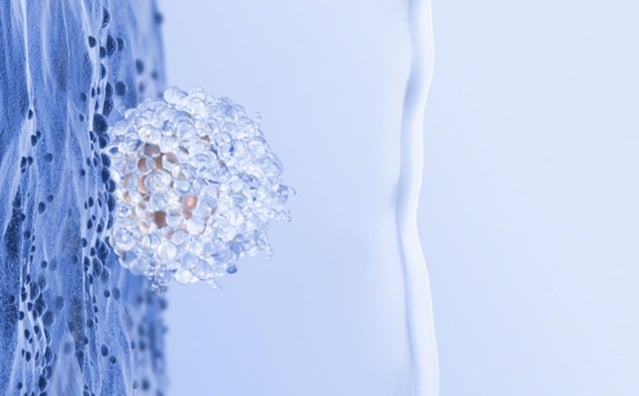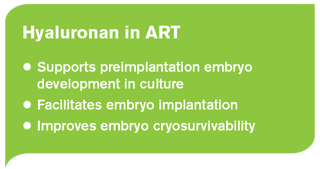Hyaluronic acid, also called hyaluronan, is a glycosaminoglycan distributed widely throughout our body. It is particularly abundant in the female reproductive tract, both in the oviduct and the uterus, which makes hyaluronan an important molecule for applications in assisted reproduction. In this blog I will focus on the role of hyaluronan in the process of embryo implantation.
Hyaluronan is a naturally occurring molecule in the body
Hyaluronan is the major glycosaminoglycan present in almost all tissues of the body where it builds up the extracellular matrix. It is also found in follicular, oviductal and uterine fluids. Hyaluronan has a lot of different functions, including contributing to tissue hydrodynamics, movement and proliferation of cells, and participates in a number of cell surface receptor interactions. It is unique among the bodies glycosaminoglycans in that it is formed in the plasma membrane instead of the Golgi apparatus and that it is present as very large molecules.
Significant importance of hyaluronan during embryo implantation
In the female reproductive tract, hyaluronan is known to provide high viscosity environments in the oviduct and uterus. Interestingly, the synthesis of hyaluronan in the uterus increases dramatically before implantation and it decreases to near basal levels after implantation.
The synthesis of most other types of glycoconjugates remains fairly constant during the implantation period. This indicates that hyaluronan plays an important role during embryo implantation whereas other molecules increasing viscosity do not. This has been demonstrated by adding human placental collagen or high levels of albumin to increase the viscosity of transfer medium, without improving implantation or pregnancy rates.
Hyaluronan supports human embryo implantation in IVF
Hyaluronan has repeatedly been shown to have an implantation promoting effect in humans. The unique combination of hyaluronan and human recombinant albumin in a transfer medium (EmbryoGlue) results in improved pregnancy- and implantation rates1, 2,3 as well as live birth rates4. It has also been shown that EmbryoGlue reduces miscarriages rates5.
The role of Hyaluronan in ART
Hyaluronan in combination with recombinant human albumin, not only facilitates implantation but also supports human embryo development during in vitro culture. It has also been demonstrated that hyaluronan and recombinant human albumin can significantly improve embryo cryosurvivability.

How does hyaluronan promote implantation?
What are the mechanisms behind this implantation promoting effect? Unfortunately there is no clear answer to this, the exact role of hyaluronan has yet to be elucidated. However, there are several possible means by which hyaluronan could facilitate implantation.
- Promote diffusion of transfer medium into the more viscous uterine secretion
A medium containing an appropriate concentration of hyaluronan, with an optimal molecular weight, provides higher viscosity in comparison to a conventional culture medium containing only proteins. The similarity in the physical properties of a viscous transfer medium and the thin uterine secretion on the surface of the epithelium could effectively facilitate the dispersal of the embryo into the luminal environment. - Improve cell-cell and cell-matrix adhesion
Hyaluronan has been shown to increase cell-cell adhesion and cell-matrix adhesion thereby functioning during the initial stages of apposition and attachment of the embryo/ blastocyst and endometrium. - Receptor mediated biological function
The cell-surface adhesion glycoprotein CD44 molecule, the hyaluronan receptor, is present throughout development from the oocyte to the blastocyst stage both in human and bovine models.
The CD44 is also expressed in human endometrium and decidua, and the expression is exclusively at the mid to late secretary phase, indicating the involvement of this molecule in the implantation process. - Degradation products of hyaluronan improve implantation
Hyaluronan can promote angiogenesis by both its degradation products and by interaction with epidermal growth factor EGF31. The latter point is of particular interest in relation to the stimulatory effect of EGF on implantation in the mouse. - Water binding capacity of hyaluronan and implantation
It has been reported that hyaluronan functions to retain water in other tissues and enhances tissue invasion processes. Consistent with this notion is the classical observation that increased fluid uptake is characteristic of early stages of implantation. These observations indicate that the water binding capacity of hyaluronan may be associated with the implantation process.
A new explanation for hyaluronan's role - upregulation of specific genes important for embryo implantation
In a recent and very interesting study6, Buck et al. (2017) presented a completely new hypothesis for the implantation promoting effect of hyaluronan. The aim of this study was to investigate the effect of hyaluronan enriched media (EmbryoGlue) on human embryo gene expression and endometrial attachment in an in vitro model. The authors suggest that EmbryoGlue may increase pregnancy rates by up-regulating genes important for implantation.
They found a significantly higher gene expression of MMP9, which encodes a protein involved in extracellular matrix degradation, and MYD88, which is an adaptor protein enabling downstream signaling from TLR4 of pro- and anti-inflammatory cytokines that may help to create a favorable environment for implantation. This may represent a mechanism behind the increase in pregnancy rates when EmbryoGlue is used as a transfer medium.
Hyaluronan is part of the most documented embryo transfer medium in IVF
Hyaluronan plays an important role in EmbryoGlue, the most studied embryo transfer medium in IVF. EmbryoGlue has been part in numerous studies and has also been part of two Cochrane meta-analysis, where it was found to increase live birth rates. EmbryoGlue is a medium developed exclusively for embryo transfer and the only existing product with a proven implantation-enhancing effect1, 2, 3, 4, 5
Download white paper to learn more about EmbryoGlue
This white paper describes the mechanisms behind EmbryoGlue and aslo provide data from studies showing that EmbryoGlue increases live birth rates.
References
1.Urman et al. Effect of hyaluronan-enriched transfer medium on implantation and pregnancy rates after day 3 and day 5 embryo transfers: a prospective randomized study. Fertil Steril 90:3. 2008.2. Bontekoe S et al. Cochrane Database Syst Rev. 2010 Jul 7;(7):CD007421. 2010.
3. Hashimoto et al. EmbryoGlue® improves pregnancy and implantation rates: results from a meta-analysis on almost 10,000 embryo transfers. PP-009, Alpha 2014. 10th Biannual conference, Antalya, Turkey. 2014.
4. Bontekoe S et al. Cochrane Database Syst Rev. 2014 Feb 25;2:CD007421. 2014.
5. Fluori C et al; The effect of EmbryoGlue on clinical outcome. P-179. Fertility 2017, Edinburgh, UK. 2017.
6. Buck C. et al; Effects of hyaluronan-rich culture media on human embryo attachment and gene expression. P-065. . Fertility 2017, Edinburgh, UK. 2017.
Topics: Embryo culture & transfer
Written by Dr. Christer Silversand
Christer “Silver” Silversand is a Senior Scientist at Vitrolife. Silver is strongly committed to improving the implantation rate and the outcome of IVF treatments. He is dedicated to quality control and culture conditions and you can often hear him lecturing passionately about the importance of minimising intracellular stress during culture of human gametes and embryos.

